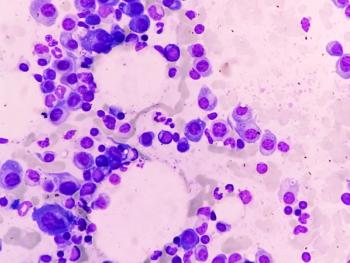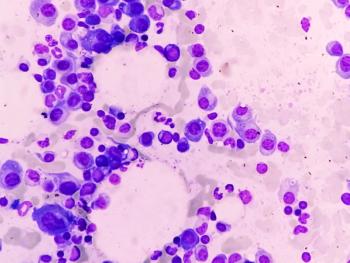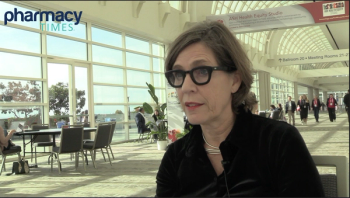
Multiple Myeloma
Latest News
Latest Videos

CME Content
More News

Emerging BCMA-Directed Therapies in Multiple Myeloma: Bispecific Antibodies and CAR T-Cell Therapies
Here is an updated overview of the role of BCMA-directed therapies following the 2024 ASCO Annual Meeting and EHA Congress.

The treatment landscape for multiple myeloma continues to evolve.

Panelists discuss the guidance on managing REMS program compliance for bispecific therapies and strategies for educating non-oncology health care providers about cytokine release syndrome (CRS) and immune effector cell–associated neurotoxicity syndrome (ICANS) toxicities.

Panelists discuss insights on infection prevention protocols and electronic health record (EHR)–based toxicity management strategies for patients receiving bispecific antibody therapies in relapsed/refractory multiple myeloma (RRMM).

Panelists discuss how clinical management of CAR T-cell therapy–associated toxicities focuses primarily on early recognition and prompt intervention with tocilizumab and/or corticosteroids for cytokine release syndrome (CRS) and immune effector cell–associated neurotoxicity syndrome (ICANS), following established grading systems and treatment algorithms.

Panelists discuss understanding institutional protocols for managing cytokine release syndrome (CRS) and immune effector cell–associated neurotoxicity syndrome (ICANS) prophylaxis in bispecific antibody therapy, along with criteria for safely selecting patients for outpatient step-up dosing.

Ira Zackon, MD, explains where future research lies regarding the implementation of bispecific antibodies in community oncology settings.

Sonja Zweegman, MD, PhD, explains the improvements in minimum residual disease negativity found after treatment with daratumumab and the VRd regimen in patients with newly-diagnosed multiple myeloma who are transplant-ineligible.

Luca Bertamini, MD highlights the potential clinical implications of using circulating tumor cells as a biomarker in patients with newly-diagnosed multiple myeloma.

The phase 3 CEPHEUS trial demonstrated that adding daratumumab (DARA) to the VRd regimen significantly improves minimal residual disease negativity, progression-free survival, and overall response in transplant-ineligible or transplant deferred patients with newly diagnosed multiple myeloma, establishing a new standard of care.

The GMMG-HD7 trial evaluated the addition of isatuximab to standard induction therapy in patients with newly diagnosed multiple myeloma who are eligible for autologous stem cell transplantation, demonstrating significantly higher rates of minimal residual disease negativity and improved progression-free survival (PFS).

Panelists discuss how bispecific antibody therapies in relapsed/refractory multiple myeloma commonly present with cytokine release syndrome (CRS), immune effector cell–associated neurotoxicity syndrome (ICANS), and increased infection risks, while talquetamab specifically exhibits distinctive adverse events including nail changes, skin reactions, and oral toxicities.

The AQUILA study demonstrates that early treatment with daratumumab significantly delays progression to symptomatic multiple myeloma, improves survival outcomes, and offers a well-tolerated alternative to traditional observation.

The therapy has similar benefits for both older and younger patients with multiple myeloma.

AI-powered drug response prediction technology is revolutionizing veterinary and human oncology by enabling personalized treatment plans through live cell testing, machine learning models, and data-driven precision medicine approaches.

Belantamab mafodotin demonstrated benefits in overall survival in the phase 3 DREAMM-7 trial.

Outpatient models are emerging as feasible alternatives to traditional inpatient care, offering potential benefits such as reduced hospitalization, improved social well-being, and cost savings.

Panelists discuss how they navigate challenges with payer coverage for quadruplet regimens in multiple myeloma treatment, including strategies they employ to address insurance denials or restrictions, such as providing clinical justification, leveraging recent trial data, and collaborating with financial assistance programs to ensure patients can access optimal therapy despite potential coverage difficulties.

LBL-034 could be best in class in treating individuals with multiple myeloma.

If accepted, daratumumab would be the first approved treatment for smoldering multiple myeloma.

Panelists discuss how treatment regimens for multiple myeloma patients can be personalized to improve adherence and quality of life by considering factors such as dosing schedules and routes of administration while emphasizing the role of pharmacists in providing resources and support to keep patients informed, engaged, and compliant with their individualized treatment plans.

Panelists discuss how pharmacists actively engage in educating and coordinating with nurses, oncologists, and other health care providers by conducting in-service trainings, participating in multidisciplinary team meetings, and collaborating on the development and implementation of formularies, order sets, and treatment protocols to ensure optimal patient care in multiple myeloma management.

Increased bone marrow adiposity is associated with progression of monoclonal gammopathy of undetermined significance (MGUS) to multiple myeloma.

In the results, 31% of patients maintained undetectable measurable residual disease 4 years after treatment.

Panelists discuss how pharmacists play a crucial role throughout the multiple myeloma patient journey, from diagnosis to treatment, by contributing to medication management, patient education, adverse effect monitoring, and the development and implementation of order sets and clinical pathways within electronic medical record systems, thereby enhancing treatment efficacy and patient safety.


















































































































































































































